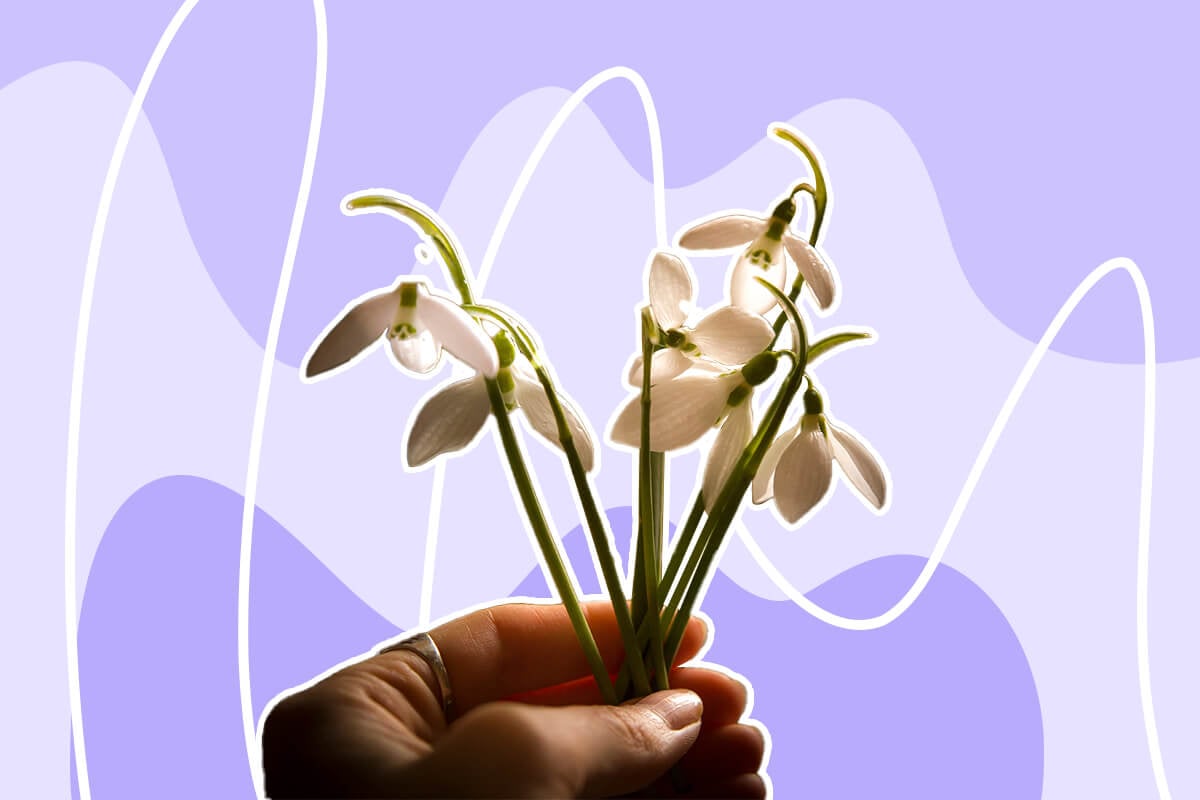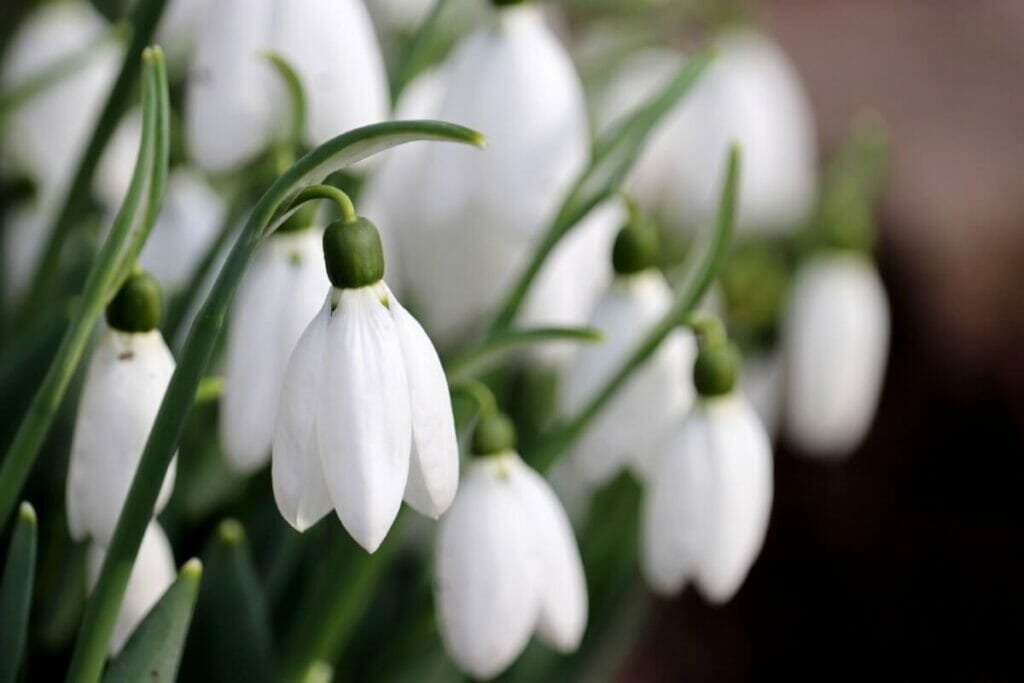The Story Behind Snowdrop Flower Meanings
Beloved for its delicate beauty, the snowdrop flower has long been a sign that winter is almost over. But that’s just one of its meanings. Snowdrop flowers have significance across cultures, with meanings ranging from modesty and purity to sympathy, fertility, and renewal. In this article, we’ll discuss everything you need to know about Snowdrop flower meaning and symbolism, with some interesting facts about their history and origins, as well as their cultural significance.

Key Takeaways
Snowdrop flowers have long been featured in myth and legend. As early heralds of spring, the blossoms symbolize hope, fertility, renewal, and rebirth, while the white petals signify purity and modesty. To the Victorians, snowdrops were associated with death. Today, snowdrops often stand for sympathy or hope in the language of flowers.
Etymological Meaning
Galanthus comes from the Greek word for “milk,” or yala, and “flower” or anthos. This refers to the blossom’s pure white color. Nivalis comes from Latin for “from the snow.”
Snowdrop Flower Myths and Legends
Snowdrops have long been associated with myths and legends across cultures. To the ancient Greeks, the flowers were known as Moly. The god Hermes gave them to humans to help them fight mental confusion caused by witchcraft.
The flowers play a role in Christian mythology, too. After being cast out of the Garden of Eden, Eve sat sobbing in the cold, bitter wind. An angel took pity on her and breathed on a snowflake, sending it fluttering down to earth. Where the snow landed, snowdrops grew.
In Romania, the flowers are known as “Daughter of the Wind.” Legend has it that each year, the sun returns to Earth at winter’s end as a young girl. One year, winter didn’t want to let go and kidnap the girl. Her beau fought the winter to free her and was wounded in the process. Where his blood spilled, snowdrops grew.
Molodovans have a similar folktale. One year, the Winter Witch refused to give up her reign, so Lady Spring fought her. The Lady pricked her finger, and snowdrops grew where her blood fell.
In Germany, legend says that God sent snow to visit every flower to decide what color they would be. The flowers were rude, except for the snowdrop. As a reward, snowdrops were allowed to bloom first but had to agree to give up their color.
Snowdrop Flowers in Art and Literature

Snowdrops appear in literature and music as well. Homer wrote: “the root was black, while the flower was as white as milk; the gods call it Moly.” Ovid also wrote of “Moly” in Metamorphoses, while Tennyson opines on Moly in The Lotus Eaters.
The poet Walter de la Mare explores the very nature of consciousness in The Snowdrop. Other poets used the flower as a symbol of spring and rebirth, such as Christina Rossetti’s February, George Meredith, and Letitia Elizabeth Landon.
Tchaikovsky set the beauty of the flowers to music in April: Snowdrop. Strauss even wrote a waltz named after the flowers in his Schneeglöckchen opus 143.
For the Victorians, the snowdrop was a symbol of bad luck or even death, perhaps because it often grew around graveyards. A snowdrop flower in the house was thought to be bad luck.
Over time, however, the snowdrop’s meaning morphed into a way to express sympathy. The flower’s connection with spring has also symbolized hope, rebirth, renewal, inspiration, and fertility.
Suitable Gifting Occasions

The snowdrop flower has long been associated with hope and renewal, thanks to being one of the first flowers to emerge in late winter and early spring. It’s a perfect addition to bouquets that are meant to inspire, create hope, and celebrate renewal, such as new baby and congratulations.
Snowdrops are also associated with sympathy. It’s an appropriate choice for funeral services or to express condolences.
As a January birth flower, snowdrops are also suitable gifts for January birthdays.
Fun Facts About Snowdrops
Here are some fun and fascinating facts about snowdrop flowers:
Natural Antifreeze
Snowdrops produce a type of antifreeze protein that helps them survive freezing temperatures, allowing them to bloom even when the ground is still frosty.
Medicinal Use
Compounds found in snowdrops have been studied for their potential in treating Alzheimer’s disease. Galantamine, derived from snowdrops, is used in some memory-boosting treatments.
Victorian Superstition
In Victorian times, it was considered bad luck to bring snowdrops indoors, as they were often associated with death and mourning due to their appearance near gravesites.
Native Habitat
Snowdrops are native to Europe and parts of the Middle East, but they’ve been widely cultivated and now brighten gardens around the world.
A Flower with Many Names
Besides “snowdrop,” they’re also known as “milk drops” and “February fair maids,” referencing their color and blooming time.
Bee-Friendly
These early bloomers are a critical food source for bees during late winter when other flowers are scarce.
Cultivar Variety
There are over 2,500 snowdrop cultivars, with some rare varieties fetching high prices at auctions. A single bulb of the ‘Golden Fleece’ cultivar once sold for nearly $2,000!
Snowdrop Festivals
In the UK, snowdrops are celebrated with festivals in late winter, where visitors admire carpets of these dainty flowers in woodland settings.
Wrap Up
Often the first flowers to emerge from the snow in late winter or spring, the delicate, beautiful snowdrop symbolizes hope and renewal. The snowdrop signified bad luck and sympathy to the Victorians, but the flowers also stand for inspiration and rebirth. These lovely blossoms grace any floral gift with their pure white color and sweet fragrance.
Madison is a writer and editor with a Bachelor’s degree in History and Political Science. She writes and photographs for various online and print publications in the gardening sphere and is the author of the book The Next-Generation Gardener.

